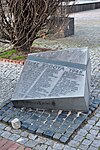Warsaw Ghetto boy

In the best-known photograph taken during the 1943 Warsaw Ghetto uprising, a boy holds his hands over his head while SS-Rottenführer Josef Blösche points a submachine gun in his direction. The boy and others hid in a bunker during the final liquidation of the ghetto, but they were caught and forced out by German troops. After the photograph was taken, all of the Jews in the photograph were marched to the Umschlagplatz and deported to Majdanek extermination camp or Treblinka. The exact location and the photographer are not known, and Blösche is the only person in the photograph who can be identified with certainty. The image is one of the most famous photographs of the Holocaust, and the boy came to represent children in the Holocaust, as well as all Jewish victims.
Excerpt from the Wikipedia article Warsaw Ghetto boy (License: CC BY-SA 3.0, Authors, Images).Warsaw Ghetto boy
Nowolipki, Warsaw Śródmieście (Warsaw)
Geographical coordinates (GPS) Address Nearby Places Show on map
Geographical coordinates (GPS)
| Latitude | Longitude |
|---|---|
| N 52.246111111111 ° | E 20.995833333333 ° |
Address
Nowolipki
00-153 Warsaw, Śródmieście (Warsaw)
Masovian Voivodeship, Poland
Open on Google Maps











